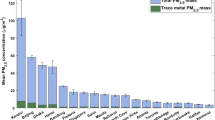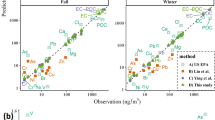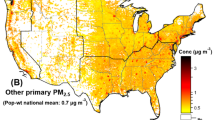Abstract
One of the most urgent needs for future progress in reducing the substantial impacts of ambient air particulate matter (PM) on human health is to determine which of its components are having the greatest effects. The EPA's Speciation Trends Network (STN) has been operating since 2000. It generates 24-h average fine PM component concentrations for sulfate and nitrate ions, elemental and organic carbon (EC/OC), and many elements on an every third or sixth day basis for one or a few sites in most large US cities. To date, a small number of research studies, summarized in this paper, have used available STN and other supplemental data to identify and quantify the influences of specific components or source-related mixtures on measures of health-related impacts. These pioneering studies have demonstrated the potential utility of using such data in analyses that can provide a sound basis for guiding future research and control activities on those PM sources that have the greatest public health relevance. Unfortunately, the STN data collection methods used are expensive, and data have therefore been too sparse for studies of short-term health effects, where semi-continuous data, or at least daily 24-h concentration data are needed, as well as for regional concentration distributions that are needed for definitive analyses. Furthermore, because of cost considerations, there is virtually no prospect of collecting the data needed by the health researchers for more definitive analyses as long as there is continued reliance on current FRM sampling and analysis methodologies. At the second EPA-HEI Workshop on “Air Quality and Health Researchers Working Together” in RTP, NC on 16 and 17 April 2008, many participants concluded that it was both desirable, and possibly technically and economically feasible, to re-equip the STN sites with an automated system of semi-continuous monitors for sulfate, nitrate, EC, OC, and semi-continuous multistage PM samplers for non-volatile elements, providing continuous records of PM components with an averaging time of ∼6 h for both thoracic coarse mode PM, fine PM, and perhaps ultrafine PM as well. The availability of such data would greatly accelerate the accumulation of knowledge on PM component exposure–response relationships that would provide a sound basis more targeted air quality standards and pollution control measures.
This is a preview of subscription content, access via your institution
Access options
Subscribe to this journal
Receive 6 print issues and online access
$259.00 per year
only $43.17 per issue
Buy this article
- Purchase on Springer Link
- Instant access to full article PDF
Prices may be subject to local taxes which are calculated during checkout









Similar content being viewed by others
Notes
HEI and EPA co-sponsored a meeting in late 2006 to discuss how the use of the accumulating data derived from nationwide monitoring of fine particulate matter (PM) components can facilitate current and future health effects studies and improve comparisons of risk estimates across studies. The workshop discussions illuminated issues associated with accessing and analyzing monitoring data and identified needs of the health effects research community regarding monitoring of fine particle components. See http://www.healtheffects.org/AQDNov06/AQDWorkshop.html for more information.
References
Allen R.W., Mar T., Koenig J., Liu S.L.J., Gould T., Simpson C., and Larson T. Changes in lung function and airway inflammation among asthmatic children residing in a woodsmoke-impacted urban area. Inhal Toxicol 2008: 20: 423–433.
Andersen Z.J., Wahlin P., Raaschou-Nielsen O., Scheike T., and Loft S. Ambient particle source apportionment and daily hospital admissions among children and elderly in Copenhagen. J Expo Sci Environ Epidemiol 2007: 17: 625–636.
Bell M.L., Dominici F., Ebisu K., Zeger S.L., and Samet J.M. Spatial and temporal variation in PM2.5 chemical composition in the United States for health effect studies. Environ Health Perspect 2007: 115: 989–995.
Burnett R., Ma R., Jerrett M., Goldberg M.S., Cakmak S., Pope III C.A., and Krewski D. The spatial association between community air pollution and mortality: a new method of analyzing correlated geographic cohort data. Environ Health Perspect 2001: 109 (Suppl 3): 375–380.
Delfino R.J., et al. Circulating biomarkers of inflammation, antioxidant activity, and platelet activation are associated with ultrafine particles and primary combustion aerosols in elderly subjects with a history of coronary artery disease. Environ Health Perspect 2008: 116 (7): 898–906.
Dominici F., McDermott A., Daniels M., Zeger S.L., and Samet J.M. National maps of the effects of particulate matter on mortality: exploring geographic variation. Environ Health Perspect 2003: 111: 39–44.
Dominici F., Peng R.D., Ebisu K., Zeger S.L., Samet J.M., and Bell M. Does the effect of PM10 on mortality depend on PM nickel and vanadium content? A reanalysis of the NMMAPS data. Environ Health Perspect 2007: 115: 1701–1703.
EPA. Ambient Air Quality Monitoring and Health Research: Summary of April 16–17, 2008 Workshop to Discuss Key Issues. EPA, Research Triangle Park, NC, 2008.
Franklin M., Koutrakis P., and Schwartz J. The role of particle composition on the association between PM2.5 and mortality. Epidemioology 2008: 19 (5): 680–689.
Hedley A.J., Wong C.M., Thach T.Q., Ma S., Lam T.H., and Anderson H.R. Cardiorespiratory and all-cause mortality after restrictions on sulphur content of fuel in Hong Kong: an intervention study. Lancet 2002, 1646–1652.
Hedley A.J., Chau P.Y.K., and Wong C.M. The change in sub-species of particulate matter [PM10] before and after an intervention to restrict sulphur content of fuel in Hong Kong. Poster presented at Better Air Quality/Asian Development Bank meeting at Agra, India 2004.
Ito K., Christensen W., Eatough D.J., Henry R.C., Kim E., Laden F., Lall R., Neas L., Larson T.V., Hopke P.K., and Thurston G.D. PM source apportionment and health effects. 2. An investigation of inter-method variations in associations between source-apportioned fine particle mass and daily mortality in Washington, DC. J Expos Anal Environ Epidemiol 2006: 15: 1–11.
Laden F., Neas L.M., Dockery D.W., and Schwartz J. Association of fine particulate matter from different sources with daily mortality in six U.S. cities. Environ Health Perspect 2000: 108: 941–947.
Lippmann M., Ito K., Hwang J.H., Maciejczyk P., and Chen L.C. Cardiovascular effects of nickel in ambient air. Environ Health Perspect 2006: 114: 1662–1669.
Mar T.F., Ito K., Koenig J.Q., Larson T.V., Eatough D.J., Henry R.C., Kim E., Laden F., Lall R.L., Stolzel M., Paatero P., Hopke P.K., and Thurston G.D. PM source apportionment and health effects. 3. Investigation of inter-method variations in associations between estimated source contributions of PM2.5 and daily mortality in Phoenix, AZ. J Expos Sci Environ Epidemiol 2006: 16: 311–320.
Peltier R.E., Hsu S.-i., Lall R., and Lippmann M. Residual Oil Combustion: a major source of airborne nickel in New York City. J Expos Sci Environ Epidemiol (in press).
Pere-Trepat E., Kim E., Paatero P., and Hopke P.K. Source apportionment of time and size resolved ambient particulate matter measured with a rotating drum impactor. Atmos Environ 2007: 41: 5921–5933.
Pope C.A., Burnett R.T., Thun M.J., Calle E.E., Krewski D., Ito K. . et al. Lung cancer, cardiopulmonary mortality, and long-term exposure to fine particulate air pollution. J Am Med Assoc 2002: 287: 1132–1141.
Pope III C.A., Burnett R.T., Thurston G.D., Thun M.J., Calle E.E., Krewski D., et al. Cardiovascular mortality and long-term exposure to particulate air pollution. Epidemiological evidence of general pathophysiological pathways of disease. Circulation 2004: 109: 71–77.
Sarnat J.A., Marmur A., Klein E., Kim E., Russel A.G., Sarnat S.E., Mulholland J.A., Hopke P.K., and Tolbert P.E. Fine particle sources and cardiorespiratory morbidity: an application of chemical mass balance and factor analytical source-apportionment methods. Environ Health Perspect 2008: 116: 459–466.
Thurston G.D., Ito k., Mar T., Christensen W.F., Eatough D.J., Henry R.C., Kim E., Laden F., Lall R., Larson T.V., Liu H., Neas L., Pinto J., Stolzel M., Suh H., and Hopke P.K. Workgroup Report: Workshop on source apportionment of particulate matter health effects—intercomparison of results and implications. Environ Health Perspect 2005: 113: 1768–1774.
US EPA. Environmental Protection Agency. Air Quality Criteria for Particulate Matter. National Center for Environmental Assessment-RTP Office, Research Triangle Park, NC, report no. EPA/600/P-99/002aF 2004.
Yue W., et al. Ambient source-specific particles are associated with prolonged repolarization and increased levels of inflammation in male coronary artery disease patients. Mutat Res 2007: 621: 50–60.
Yue W., et al. Source apportionment of ambient fine particle size distribution using positive matrix factorization in Erfurt, Germany. Sci Total Environ 2008: 398 (1–3): 133–144.
Acknowledgements
The preparation of this paper was supported by a research grant from the Health Effects Institute, and is part of a Center Program supported by Grant ES 00260 from the National Institute of Environmental Health Sciences.
Author information
Authors and Affiliations
Corresponding author
Additional information
On the basis of an invited lecture entitled: “Air Quality and Health Researchers Working Together: Stories of Success”, and invited commentary at the Workshop closing session, both presented the EPA/HEI Second Workshop to Discuss Key Issues on Ambient Air Quality and Health Research at Research Triangle Park, NC, 16 and 17 April 2008.
Rights and permissions
About this article
Cite this article
Lippmann, M. Semi-continuous speciation analyses for ambient air particulate matter: An urgent need for health effects studies. J Expo Sci Environ Epidemiol 19, 235–247 (2009). https://doi.org/10.1038/jes.2008.65
Received:
Accepted:
Published:
Issue Date:
DOI: https://doi.org/10.1038/jes.2008.65
Keywords
This article is cited by
-
The sensitivity of health effect estimates from time-series studies to fine particulate matter component sampling schedule
Journal of Exposure Science & Environmental Epidemiology (2013)
-
Particulate matter (PM) air pollution and health: regulatory and policy implications
Air Quality, Atmosphere & Health (2012)
-
Source apportionment of ultrafine and fine particle concentrations in Brisbane, Australia
Environmental Science and Pollution Research (2012)
-
Air pollution and health: bridging the gap from sources to health outcomes: conference summary
Air Quality, Atmosphere & Health (2012)
-
Baltimore PM2.5 Supersite: highly time-resolved organic compounds—sampling duration and phase distribution—implications for health effects studies
Analytical and Bioanalytical Chemistry (2011)



